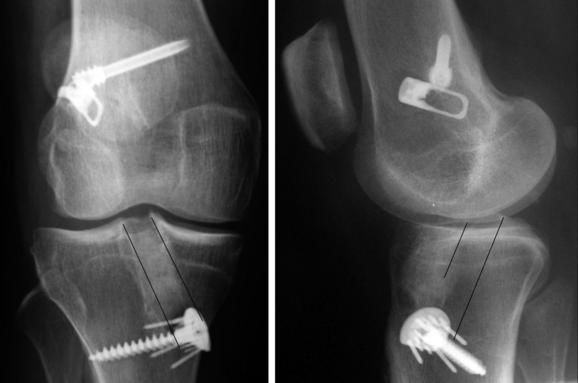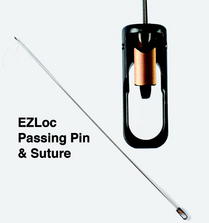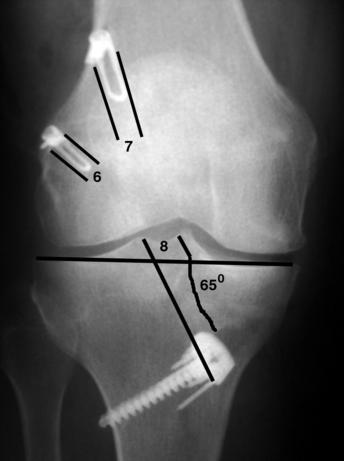Chapter 33 EZLoc Femoral Fixation of a Soft Tissue Graft
Introduction
Fixation of the looped end of a soft tissue ACL graft to the femur poses different challenges than fixation of the free ends to the tibia. Metal cross-pin devices such as the Bone Mulch Screw and Transfix have set the standard for femoral fixation because of their superior slippage resistance, stiffness, and strength.1–4 Although these metal cross-pin devices work extremely well, their surgical techniques consists of multiple challenging steps and a lateral incision through the iliotibial band, which can damage the lateral collateral ligament.5 Prominent seating of the head of the cross-pin causes iliotibial band pain,6 and countersinking below the cortex complicates and may prevent hardware removal at the time of revision surgery (Fig. 33-1).
Design, Diameter, Length, Packaging, and Mechanism of the EZLoc
The EZLoc is a cortical fixation device that consists of a deployable lever arm connected to an axle in a slotted body through which the ACL graft is looped. The lever arm grips cortical bone on the anterolateral side of the femur, which provides superior slippage resistance, high stiffness, and strong cortical fixation. The lever arm provides rigid fixation that is better than that of a cross-pin because the lever arm seats on cortical bone on the anterolateral femur, which is 50 times stronger than cancellous bone7 (Fig. 33-2).
The EZLoc comes in different lengths, which control the length of the graft in the femoral tunnel and ensure that enough graft extends beyond the tibial tunnel for secure fixation. The most commonly used EZLoc length is the standard version. The standard version is used in a femoral tunnel from 35 to 50 mm in length, which provides 22 to 37 mm of soft tissue graft in the tunnel, promoting rapid, stiff, and strong tendon tunnel healing.8–10 The long version is used in a femoral tunnel that is longer than 50 mm, and the length of the soft tissue graft in the femoral tunnel is computed by subtracting 22 mm from the length of the lateral wall of the femoral tunnel. The short version is used in a femoral tunnel that is shorter than 35 mm, and the length of the graft in the tunnel is computed by subtracting 7 mm from the length of the lateral wall of the femoral tunnel.
For ease of use, each EZLoc comes preassembled on a 16-inch-long, sharp-tip passing pin that is secured by a suture tied under tension and is sterile (Figs. 33-3 and 33-4). The suture has two functions: to keep the passing pin in the body of the EZLoc during passing of the graft and to deploy the lever arm once the lever arm clears the femoral tunnel. The suture passes through a hole in the lever arm and through two holes at the sharp end of the passing pin. The suture is tied under tension, which keeps the dull end of the passing pin inside the EZLoc and keeps the lever arm undeployed. The lever arm is positioned laterally, tension is applied to the pin, and the EZLoc and soft tissue graft are pulled across the knee. Once the ACL graft is pulled into the femoral tunnel, the suture is cut, the passing pin is removed, the suture is tensioned, and the lever arm deploys.
Fixation Properties of the EZLoc
A successful ACL reconstruction with a soft tissue graft depends on the use of a femoral fixation device that has superior fixation properties and enhances biological healing of the tendon to the tunnel wall. The fixation properties of the femoral fixation device should provide high strength and high stiffness, be resistant to slippage, and allow circumferential healing of the tendon to the tunnel wall.4,9,11–13 Because a soft tissue graft takes longer to heal to the tunnel than a bone plug, the femoral fixation of a soft tissue graft should be more slippage resistant, stiffer, and stronger than the femoral fixation of a bone plug graft.14
The use of the EZLoc to fix a soft tissue graft in the femur is a sound choice because its fixation properties are second to none and the device allows circumferential healing. The strength of the EZLoc is 1427N, which is stronger than the closed-loop Endobutton (1086N) and the cross-pins (Bone Mulch Screw, 1112N; Transfix, 1303N; RigidFix, 868N).2,15 The stiffness of the lever arm of the EZLoc on cortical bone is infinitely high compared with the stiffness of the more elastic soft tissue graft. A benefit of using a high-stiffness femoral fixation device such as the EZLoc is that the tension applied to the graft to restore anterior laxity is lowered4,12,13,16 and the risk of developing anterior laxity during early motion is lessened.11 The slippage resistance of the EZLoc under cyclical loading has not been measured; however, the slippage with a metal lever arm on cortical bone should be at least as small as a cross-pin because the mechanism of looping the graft over a metal post is identical in both types of fixation methods.17 The EZLoc promotes healing of the tendon to the tunnel wall better than an interference screw because the soft tissue graft fixed with the EZLoc heals circumferentially to the tunnel wall.9
The combination of the EZLoc with the WasherLoc and bone dowel tibial fixation device creates a graft-fixation device construct with superior fixation properties that allow an early, aggressive, and brace-free rehabilitation.18 With this fixation technique and correct tunnel placement, the majority of patients regain sufficient function and confidence in their knee to return to preinjury activity level 4 months after reconstruction, similar to femoral fixation with the Bone Mulch Screw.19













